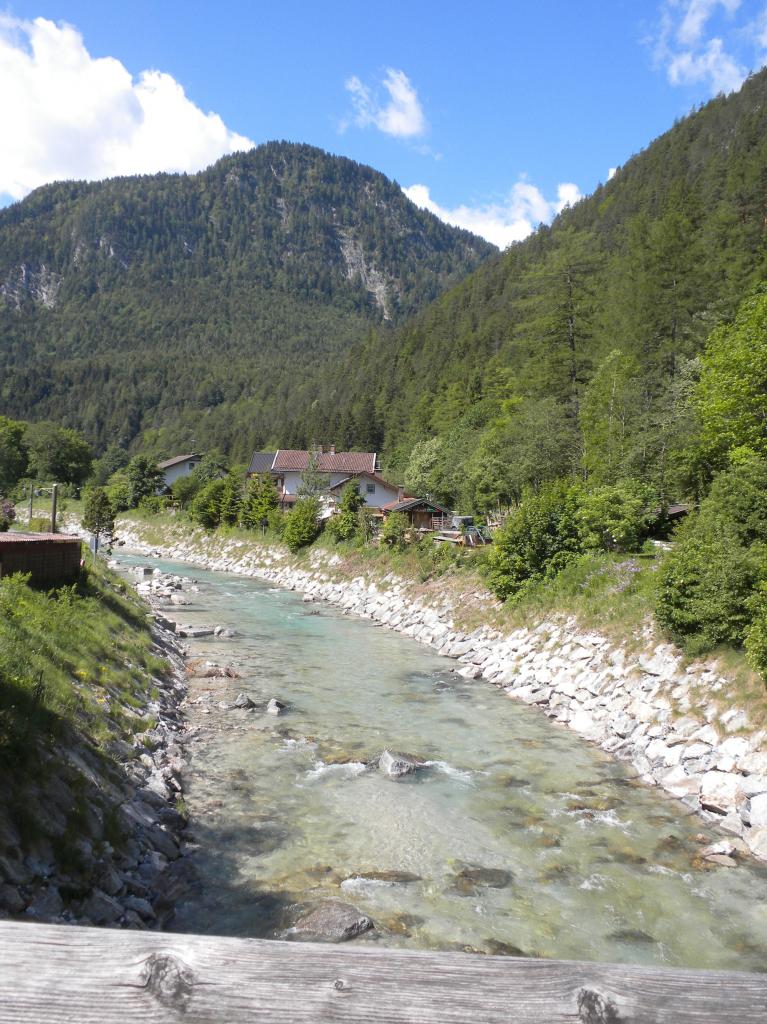Painted Bavaria
The Painted Village

High up in the German Alps sits the picturesque Bavarian town of Mittenwald. Its name translates to "in the middle of the forest," which is a bit strange, because there's more meadow and mountain than forest. Famous for its high-quality string instruments, stepping into Mittenwald feels like you've stepped into a veritable fairytale. It seems the ideal setting for one of the Brothers Grimm's stories, and with its charming, little streams and views of the surrounding mountains, the town is certainly not wanting in beauty. But my favorite part was definitely the fresco-adorned houses, which I'll get to in a bit.
Since we were going to multiple places in Bavaria, we decided to rent a car in Budapest. I drove nearly the entire way there and got to experience the Autobahn, where yes, you can drive as fast as you want but only on a limited stretch of the highway. For most of it, though, there is a speed limit, much to my disappointment. Nevertheless, the drive was incredibly beautiful, with valleys, forests, and mountains practically hugging the scenic roads, and we reached Mittenwald in about six hours.
I fell in love with the town as soon as I parked the car.
Painted Houses

The frescoes are all colorful, all beautiful, but the subject matters vary. Some, like the churches, are painted with religious scenes--Christ, the Virgin Mary, and the like. Others have men, women, and children dressed in ornate, historical clothing, possibly depicting German royalty or Bavarian nobility. But most paintings are visual representations of traditional stories, daily life, and fairytales, the latter of which are rather apt, considering the town's Brothers Grimmesque atmosphere. In fact, I'm pretty sure I saw the Big Bad Wolf chasing Little Red Riding Hood around one of the houses...
These frescoed buildings--called Lüftlmalerei--are not unique to Mittenwald, though they do seem to cluster there the most; if you visit other Bavarian towns, you will find similarly beautiful paintings. This form of decoration began in the Baroque period, in the 1600s, as an inexpensive way to mimic the artistic styles of the grand palaces. It was also a way to document the towns' history, which means that nearly all of the paintings are over 300 years old. When I visited Mittenwald, workers were in the process of restoring a building's gorgeous fresco of white horses.
Saint Peter and Paul Church

True to the town's form, the exterior of this church is adorned with colorful paintings, but its interior is just as rainbow-bright. I've been inside a lot of religious buildings in a lot of countries, but never before have I seen so much pink in a church. The walls and ceiling are a very pale pink, almost white, and the columns are made of a pinkish red marble. Elaborate frescoes further liven up the Roman Catholic church, the most magnificent of which is on the dome. If the slightly kitschy interior surprises you, it is actually quite common in Rococo, the style in which the church was constructed and decorated between 1738 and 1740. The Saint Peter and Paul Church is by far one of the most memorable religious buildings I've seen.
Violins
 Painted buildings are not the only over-the-top craftwork found in Mittenwald. Littered all around town are giant musical instruments and notes. There's a violin carved from a tree that's at least twice my height. The music shop is accented with a large treble clef. And there's even a part of town dedicated solely to music, where one can buy a renowned Klotz violin or cello.
Painted buildings are not the only over-the-top craftwork found in Mittenwald. Littered all around town are giant musical instruments and notes. There's a violin carved from a tree that's at least twice my height. The music shop is accented with a large treble clef. And there's even a part of town dedicated solely to music, where one can buy a renowned Klotz violin or cello.
The reason Mittenwald is so gaga for string instruments is because of the Klotz family. In the mid-17th century, they began making violins, violas, and cellos for the residents. But their products were so lovely and of such high-quality that other towns, cities, and even countries snapped them up. If you want a comparison, Klotz is the German equivalent of the famous Finnish Stradivarius.
Mountain Stream
 The entire landscape is breathtakingly beautiful, but I grew especially fond of the mountain stream that babbled behind our hotel. The water was the clichéd crystal-clear and as cold as ice, as it was melt-off from the Bavarian Alps. Where ever you went in the town, the stream seemed to follow you. It rushed below your feet as you crossed the bridge into the central square, and it split off into tiny streams that flowed and pooled in special channels throughout the town. I even accidentally stepped in one because I wasn't looking where I was walking. But I amended my mistake by taking many, many pictures of and with the parent stream.
The entire landscape is breathtakingly beautiful, but I grew especially fond of the mountain stream that babbled behind our hotel. The water was the clichéd crystal-clear and as cold as ice, as it was melt-off from the Bavarian Alps. Where ever you went in the town, the stream seemed to follow you. It rushed below your feet as you crossed the bridge into the central square, and it split off into tiny streams that flowed and pooled in special channels throughout the town. I even accidentally stepped in one because I wasn't looking where I was walking. But I amended my mistake by taking many, many pictures of and with the parent stream.






